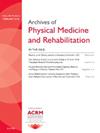下肢静脉曲张术后早期行走延迟行为的预测模型:一项前瞻性病例对照研究。
IF 3.6
2区 医学
Q1 REHABILITATION
Archives of physical medicine and rehabilitation
Pub Date : 2024-10-01
DOI:10.1016/j.apmr.2024.06.004
引用次数: 0
摘要
目的:分析下肢静脉曲张术后早期行走延迟的影响因素并建立预测模型:分析下肢静脉曲张(VVLE)术后早期下床活动延迟的影响因素并建立预测模型:前瞻性病例对照研究:环境:从当地两家医院招募下肢静脉曲张患者:干预措施:不适用:主要结果测量:主要结果测量:在手术前收集参与者的信息,并随访至术后第二天,然后将其分为正常组和延迟行走组。根据手术和麻醉类型对所有参与者进行倾向得分匹配(PSM)。使用逻辑回归、反向传播神经网络(BPNN)和决策树模型对两组的所有信息进行比较。比较了三种模型的准确性、灵敏度、特异性和曲线下面积(AUC),以确定最佳模型:结果:共有 406 名参与者接受了 PSM。逻辑回归模型、BPNN 模型和决策树模型训练集的 AUC 分别为 0.850、0.932 和 0.757。测试集的 AUC 分别为 0.928、0.984 和 0.776。BPNN 是最佳模型。SSRS评分、术前30秒坐立测试评分、CEAP分级、MCMQ评分和是否知道需要早期下床活动,依次为BPNN模型的结果。概率值大于 0.56 表示延迟早期下床活动:临床医生应更多地关注 SSRS 评分较低、下肢力量较差、CEAP 分级较高、医疗应对能力较差的患者,让患者意识到早期下地活动的必要性和重要性,从而协助术后康复决策。还需要进一步研究改进方法,增加更多变量,并将模型转化为量表,以提前筛查和干预 VVLE 早期下地活动的延迟行为。本文章由计算机程序翻译,如有差异,请以英文原文为准。
Prediction Model for Delayed Behavior of Early Ambulation After Surgery for Varicose Veins of the Lower Extremity: A Prospective Case-Control Study
Objective
To analyze influencing factors and establish a prediction model for delayed behavior of early ambulation after surgery for varicose veins of the lower extremity (VVLE).
Design
A prospective case-control study.
Setting
Patients with VVLE were recruited from 2 local hospitals.
Participants
In total, 498 patients with VVLE were selected using convenience sampling and divided into a training set and a test set.
Interventions
Not applicable.
Main Outcome Measures
We collected information from the selected participants before surgery and followed up until the day after surgery, then divided them into a normal and delayed ambulation group. Propensity score matching was applied to all participants by type of surgery and anesthesia. All the characteristics in the 2 groups were compared using logistic regression, back propagation neural network (BPNN), and decision tree models. The accuracy, sensitivity, specificity, and area under the curve (AUC) values of the 3 models were compared to determine the optimal model.
Results
A total of 406 participants were included after propensity score matching. The AUC values for the training sets of logistic regression, BPNN, and decision tree models were 0.850, 0.932, and 0.757, respectively. The AUC values for the test sets were 0.928, 0.984, and 0.776, respectively. A BPNN was the optimal model. Social Support Rating Scale score, preoperative 30-second sit-stand test score, Clinical-Etiology-Anatomy-Pathophysiology (CEAP) grade, Medical Coping Modes Questionnaire score, and whether you know the need for early ambulation, in descending order of the result of a BPNN model. A probability value greater than 0.56 indicated delayed behavior of early ambulation.
Conclusions
Clinicians should pay more attention to those with lower Social Support Rating Scale scores, poor lower limb strength, a higher CEAP grade, and poor medical coping ability, and make patients aware of the necessity and importance of early ambulation, thereby assisting decision-making regarding postoperative rehabilitation. Further research is needed to improve the method, add more variables, and transform the model into a scale to screen and intervene in the delayed behavior of early ambulation of VVLE in advance.
求助全文
通过发布文献求助,成功后即可免费获取论文全文。
去求助
来源期刊
CiteScore
6.20
自引率
4.70%
发文量
495
审稿时长
38 days
期刊介绍:
The Archives of Physical Medicine and Rehabilitation publishes original, peer-reviewed research and clinical reports on important trends and developments in physical medicine and rehabilitation and related fields. This international journal brings researchers and clinicians authoritative information on the therapeutic utilization of physical, behavioral and pharmaceutical agents in providing comprehensive care for individuals with chronic illness and disabilities.
Archives began publication in 1920, publishes monthly, and is the official journal of the American Congress of Rehabilitation Medicine. Its papers are cited more often than any other rehabilitation journal.

 求助内容:
求助内容: 应助结果提醒方式:
应助结果提醒方式:


